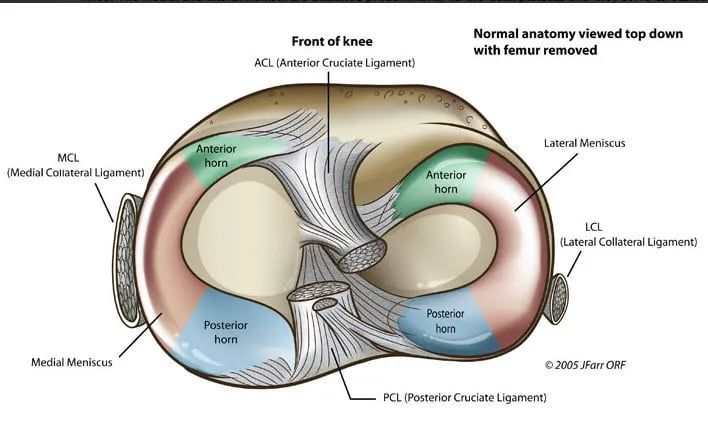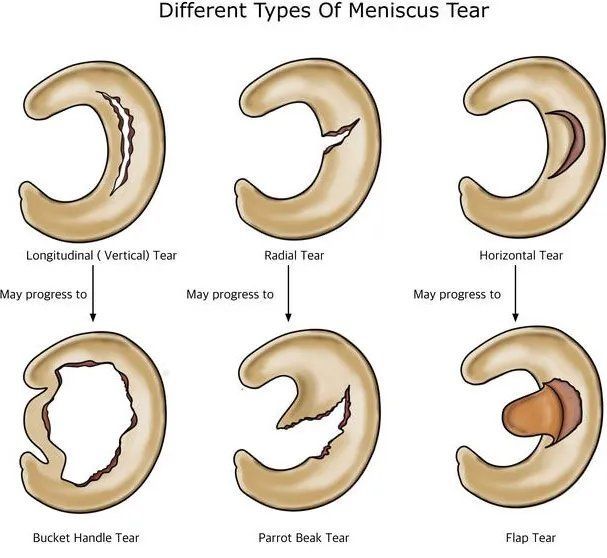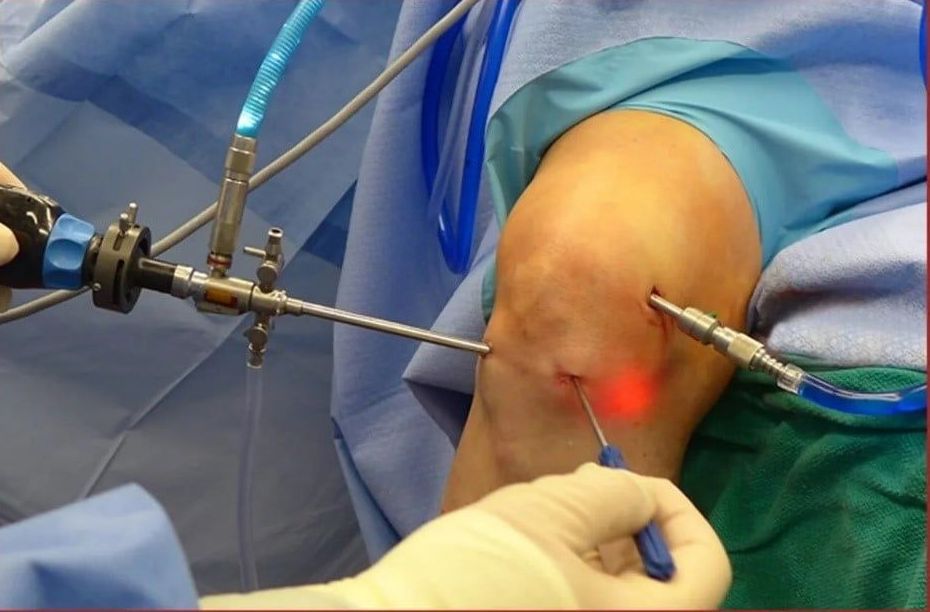Meniscal Repair: Understanding the Surgery and Recovery Process
🔳Overview
A meniscal tear is a common knee injury that results from turning, twisting, or jarring the knee. Though some tears may mend by themselves with proper rest and physical therapy, others require surgery. The meniscus has limited vascularization which results in poor blood flow. Poor blood flow often inhibits the meniscus from fully healing. Often, the only way to get the meniscus to heal is to have a surgeon perform a meniscal repair. This article will give a general description of meniscal repair surgery, as well as the healing process and what to anticipate following the procedure.
Understanding Meniscal Tears
The meniscus, a C-shaped piece of cartilage, serves as a shock absorber in the knee joint between the femur (thigh bone) and tibia (shinbone). Meniscal tears can happen as a result of a rapid rotation or twisting of the knee, as well as from aging-related or wear-and-tear-related degenerative changes.
Meniscal tears come in three different varieties:
Radial tears
These extend from the inner rim of the meniscus to the outer edge. If not treated these tears can progress to parrot beak tears.
Longitudinal tears
These occur along the length of the meniscus. If not treated these tears can progress to a bucket handle tear.
Horizontal tears
These occur in a horizontal orientation parallel to the tibial plateau. If not treated these tears can progress to a flap tear.
Who needs to have meniscus tear surgery?
Meniscal surgery may be required for patients with a substantial meniscus tear that does not heal with rest or non-invasive treatment. Surgery is often advised by a doctor if the patient is suffering from mechanical symptoms like seizing or shutting in the knee joint or if the tear is resulting in ongoing discomfort, swelling, and restricted mobility. The decision to undergo a meniscal repair surgery is decided on a case-by-case basis after a thorough examination of the patient. Age is a major factor surgeon consider when deciding between treating a meniscal tear with a repair or a resection.
🔳The procedure: Before, During, and After
What happens before meniscal repair surgery?
The patient will normally go through a thorough examination by a physician or orthopedic surgeon before meniscal repair surgery to ascertain the severity of the injury and the best course of action. A physical examination, imaging tests like X-rays or an MRI, and a talk of the patient's concerns and medical background may all be a part of this evaluation.
If it is determined that surgery is needed, the patient will receive directions on pre-operative instructions which may include limitations on what they can eat and drink before the procedure. Also, the patient might have to stop taking any vitamins or medications that could affect the procedure or the patient's ability to recuperate.
The surgical team and anesthesiologist will meet with the patient before the actual procedure to go over the specifics of the treatment and what to anticipate during and after the surgery. The patient will generally sign a consent document as well, attesting to their knowledge of the procedure's advantages and disadvantages and their willingness to move forward with it.
The patient may also engage in rehabilitation activities or physiotherapy to increase the range of motion and mobility while also strengthening the tissues around the knee. This may facilitate the best possible surgical result and hasten the healing process.
What happens during meniscal repair surgery?
The patient is given general anesthesia during meniscal repair surgery, which means they are entirely unconscious and uninformed throughout the treatment. The surgical team would then access the meniscus by making a few tiny incisions in the knee.
The surgeon will then look at the torn meniscus with specialist tools and a device called an arthroscope and take out any frayed or damaged tissue. The surgeon may well be capable of fixing the meniscus using sutures or an ‘all inside’ repair device, depending on the precise spot and size of the tear.
The surgical team will sew up the incisions after the repair is finished and dress or bandage the knee. Once the anesthetic has worn off, the patient will be transferred to a triage area where they can be watched closely for any issues.
Depending on the severity of the lesion and the surgeon's chosen approach, the surgery's duration can change. Meniscal repair surgery, however, normally takes one to two hours to complete. (see photo below)
What happens after meniscal repair surgery?
The patient will normally be watched in a recovery room for a while following meniscal repair surgery to make sure they are starting to wake up from the anesthetic correctly and that their vitals are stable. After receiving the all-clear to return home, the patient will be provided with precise guidelines on how to take care of their knee and control discomfort during the healing process.
These guidelines could state:
- Use cold packs and maintaining the knee elevated to decrease swelling.
- putting no pressure on the knee for a while by using a walker or crutches
- following the doctor's advice and using prescription or over-the-counter painkillers
- following a specific physical therapy or rehab program to strengthen the muscles around the knee and help it heal.
- sprinting or jumping, which could put stress on the knee for a while.
Getting better after meniscal repair surgery can take different amounts of time, depending on how bad the injury was and what kind of surgery was done. It could take up to one year for the knee to fully recover, and most patients can resume their typical activities a few months to a few years after the operation.
Usually, the patient will have follow-up meetings with the surgeon to assess their recovery and make sure the knee is recovering appropriately. The patient should speak with their surgical team right away if there are any issues or complications during the healing process.
🔳Risks and Benefits
What are the benefits?
The following are a few potential advantages of meniscal repair surgery:
- Pain relief: Tears in the meniscus can be very painful, especially when the knee is bent or twisted. The procedure can help to lessen knee pain and discomfort by fixing the tear.
- Improvement of function: A torn meniscus can make it hard to move or put weight on the knee that is hurt. By fixing the tear, surgery can help the knee get back to its normal range of motion and use.
- Faster recovery from meniscus repair surgery: When compared to other surgeries like partial meniscectomy, which removes part of the meniscus, meniscal repair surgery may sometimes lead to a faster and less painful recovery.
- Decreased chance of getting arthritis: If a meniscal tear is left untreated, the likelihood of getting arthritis in the afflicted knee will increase. The surgery can aid in lowering this risk and preserving the knee joint's long-term health by fixing the tear.
- Avoiding a knee replacement: In some cases, a meniscal repair procedure can help a patient avoid having to have a more invasive knee replacement procedure in the future.
Of course, the specific advantages of meniscal repair surgery may vary depending on the severity of the damage, the patient's age and degree of activity, and the surgical approach is taken. To evaluate the best strategy and potential advantages for the patient's needs and circumstances, the surgical team will consult with them.
What are the risks?
Meniscal repair surgery can cause the same kinds of problems and risks as any other kind of surgery. Among the most prevalent dangers are:
- Infection: Each surgical technique carries an inherent risk of infection. By following proper surgical standards, such as employing sterile equipment and techniques, the risk of infection can be reduced.
- Blood clots: Surgery and extended immobility can raise the chance of forming blood clots in the legs, which may be life-threatening if they reach the lungs.
- Damage to nerves or blood vessels: During surgery, the nerves and blood vessels around the knee joint could be hurt, which could cause numbness, weakness, or other problems.
- Knee stiffness or a limited range of motion: Some patients may feel knee stiffness or a limited range of motion after surgery, which can make it hard for them to do daily tasks.
- Failed Repair: In some cases, the repair may not work, and the meniscus may have to be taken out in part or in whole.
Before having meniscal repair surgery, it is essential for patients to discuss these hazards and possible problems with their surgeon and to carefully adhere to all post-operative recommendations to reduce their chances of difficulties.
🔳Recovery
Recovery from Meniscal Repair Surgery
Getting better after meniscal repair surgery depends on a lot of things, like how bad the damage was, what kind of surgery was done, and how healthy and active the patient is in general. Still, there are some general rules that might help patients know what to expect during the healing process.
Patients who just had knee surgery will likely have pain, swelling, and stiffness right after the surgery. The patient will be given special instructions for controlling the swelling and pain during the recovery phase, as well as pain medication and cold packs.
After knee surgery, patients are often told to put as little weight as possible on the injured knee for a while, and they may be given a walker or a brace for extra support. Physical treatment may also be prescribed to improve the knee's motion range and strength.
The length of the recovery from meniscus repair surgery depends on the patient's age, how active they are, how bad the damage is, and how the surgery was done. After knee surgery, most people can get back to their normal daily activities within a few weeks, but it may be necessary to wait a few weeks before doing more strenuous activities or sports so that the knee can heal properly.
For the best possible outcome and to lower the risk of problems, it's important for patients to follow all post-surgery instructions from their surgeon and physical therapist, as well as any exercises and stretches they're told to do.
-
What are the 3 types of meniscus repairs?
Meniscus repair procedures include partial meniscectomy, meniscal repair, and meniscal replacement. Meniscal repair includes stitching the torn margins of the meniscus back together, whereas partial meniscectomy means removing the injured portion of the meniscus. Meniscus replacement entails the replacement of the whole meniscus with an artificial implant. The appropriate type of surgery will vary depending on the position and degree of the meniscus tear.
-
How long does it take to recover from a meniscus repair surgery?
Depending on the degree of the damage and the surgical procedure performed, meniscus repair surgery recovery times can vary. Patients should often anticipate needing crutches for a couple of weeks and may require physical therapy for a few months. Three to six months are required for a full recovery.
-
How long does it take to walk after meniscus surgery?
The length of time required to recover from meniscus surgery depends on the scope of the procedure and the patient's overall condition. Yet, after a few days of surgery, the majority of patients are capable of walking with crutches or a brace and can return to normal activities within four to six weeks. To ensure a complete recovery, it is essential to adhere to your doctor's post-operative recommendations and attend physical therapy.
-
Is meniscus repair a major surgery?
The operation to repair a torn meniscus is regarded as a substantial procedure, although it is normally performed on an outpatient procedure, meaning you can come back home on the same day. Depending on the severity of the damage and the surgical procedure performed, full recovery might take anywhere from many weeks to several months.
What do we look for in a surgeon that performs Meniscal Repair?
- Our Surgical Sources must be comfortable sending their family members to the surgeon.
- The surgeon must specialize in meniscal surgery and be a high-volume surgeon.
- The surgeon must be board-certified and have a good track record of successful surgeries.
- The surgeon must be performing meniscal repairs weekly.
- The surgeon must use the latest technology and equipment.
- The surgeon must have good hand-eye coordination.
Surgeon Researcher – Final Words
The best predictor of successful surgery is the skill level of your surgeon. Surgeons are NOT created equal.
Studies, and our experience, show that patients who are operated on by the most skilled surgeons have lower rates of revision surgery, complications, infection, pain, opioid use, and death. The most skilled surgeons achieve the best surgical outcomes - providing you with the quickest recovery and best quality of life.
Finding the most skilled surgeon can be an impossible task if you do not work in the medical industry. Surgeon Researcher is here to change that.
The only sources that know how skilled a surgeon really is are in the operating room with surgeons on a consistent basis.
We talk to these sources.
We are the only service dedicated to finding patients like you the most qualified surgeons in the country by going straight to the source. Our goal is to equip you with all the information you need to make an informed choice about your health care.
Here at Surgeon Researcher, we prioritize the needs of our customers. We are advocates for the patients, not surgeons.
Don't risk your future quality of life. Get in touch with Surgeon Researcher so we can ensure a qualified surgeon is performing your surgery. You can rely on us to be your advocate in the fight for better surgical outcomes.




